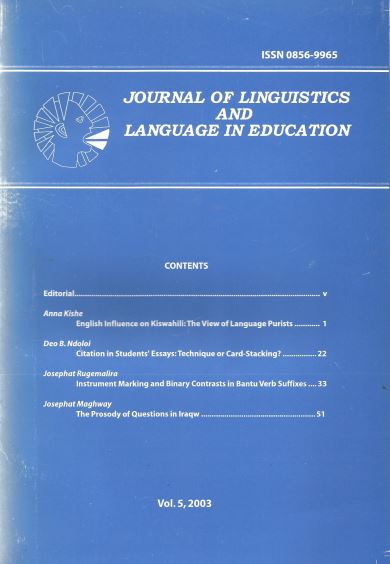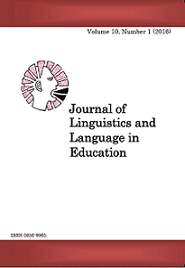Instrument Marking and Binary Contrasts in Bantu Verb Suffixes
Abstract
The description of the applicative and causative suffixes is usually cast in terms of the semantic (thematic) roles associated with each suffix. The applicative is often associated with the beneficiary and goal roles, while the causative suffix is described as introducing a higher agent (causer). Such analysis is situated within the framework of an assumed finite set of semantic roles, which include agent, patient/theme, instrument, goal, beneficiary, locative, etc. Dowty (1991) showed the traditional problems involved in the identification of semantic roles. The problems include role fragmentation and unclear boundaries, improper application of syntactic or semantic criteria in semantic role identification, and the failure of semantic roles to adequately distinguish arguments, especially in cases where the same role can be assigned to two arguments of the same predicate structure. Dowty proposed that instead of the "traditional system of discrete roles" linguistic theory should make use of two macro-roles, viz. protoagent and proto-patient.References
Alsina, A. (1992). On the Argument Structure of Causatives. Linguistic Inquiry 23/4:517-555.
------- and S. Mchombo (1993). Object Assymmetries in Chichewa. In Mchombo (ed.) Theoretical Aspects of Bantu Grammar. Palo Alto: CSLI Publications.
Ashton, E. O., E. M. K. Mulira, E. G. M. Ndawula, & A. N. Tucker. (1954). A Luganda Grammar. London: Longmans.
Baker, M. (1988). Incorporation: A Theory of Grammatical Function Changing. Chicago: University of Chicago Press.
Baumbach, E. J. M. (1987). Analytical Tsonga Grammar. Pretoria: University of South Africa.
Bentley, W. H. (1967). Dictionary and Grammar of the Kongo Language. Farnborough: Gregg Press.
Bresnan, J. and L. Moshi (1990). Object Assymetries in Comparative Bantu Syntax. Linguistic Inquiry 21: 147-185.
Cole, D. T. (1955). An Introduction to Tswana Grammar. London: Longmans.
Cole, P. and J. Sadock (eds.) (1977). Syntax and Semantics 8: Grammatical Relations. New York: Academic Press.
Doke, C. M. (1955). Zulu Syntax and Idiom. London: Longmans.
Dowty, D. (1991). Thematic Proto-roles and Argument Selection. Language 67:547-619.
Emmanatian, M. (1991). Grammatical Polysemy: The Systematicity of Multiple Meanings in Grammar. Ph D Dissertation. University of California, Berkeley.
Fillmore, C. J. (1968). The Case for Case. In E. Bach and R. Harms, Universals in Linguistic Theory. New York: Holt, Rinehart, and Winston.
------- (1977). The Case for Case Reopened. In P. Cole & J. Sadock (eds.).
Givon, T. (1971). On the Verbal Origin of the Bantu Verb Suffixes. Studies in African Linguistics. 2: 145-163.
------- (1976). Some Constraints on Bantu Causativisation. In Shibatani (ed.).
Gould, L. J. (1987). Evidence of Ambiguous Targets in Kuria Advancement Strategies. In David Odden (ed.) Currrent Approaches to African Linguistics, vol. 4 Dordrecht: Foris.
Grimshaw, J. (1990). Argument Structure. Cambridge. MIT Press.
Guthrie, M. (1935). Lingala Grammar and Dictionary. Conseil Protestant du Congo.
------- (1970). Collected Papers in Bantu Linguistics. London: Gregg
------- (1971). Comparative Bantu. Vol.1-4. Farnborough: Gregg.
Hawkinson, A. and L. Hyman (1974). Hierarchies of Natural Topic in Shona. Studies in African Linguistics. 5:147-170.
Heine, B. (1972). Zur genetischen Gliederung der Bantusprachen. Afrika und Ubersee 56:164-185.
Hodges, K. S. (1977) Object Relations in Kimeru Causatives. Studies in the Linguistic Sciences. 6:108-141.
------- and S. U. Stucky (1979. On the Inadequacy of a Grammatical Relations Referring Rule in Bantu. Studies in the Linguistic Sciences. 9:91-99.
Jackendoff, R. (1987). The Status of Thematic Relations in Linguistic Theory. In Linguistic Inquiry 18: 369-411.
Jalla, A. (1982). Silozi-English Dictionary. 3rd edition. Lusaka: National Educational Company of Zambia.
Kanyoro, R. A. (1983). Unity and Diversity: a Linguistic Survey of the Abaluhyia of Western Kenya. Wien:Veroffentlichungen der Institute fur Afrikanistik und Agyptologie der Universitat Wien.
Khamisi, A. M. (1985). Swahili Verb Derivation. PhD Dissertation. University of Hawaii.
Kimenyi, A. (1980). A Relational Grammar of Kinyarwanda. Berkeley: University of California Press.
Kisseberth, C. and M. Abasheikh (1977). The Object Relation in Chimwiini, a Bantu Language. In Cole and Sadock (eds). Op. cit.
Lanham, L. W. (1955). A study of Gitonga of Inhambane. Johannesburg: Witwatersrand University Press.
Machobane, Malilo M. (1989). Some Restrictions on the Sesotho Transitivizing Morphemes. PhD Dissertation. McGill University.
Mchombo, Samuel A. (1991). Reciprocalisation in Chichewa; a Lexical Account. Linguistic Analysis 21:3-22.
Mchombo, Samuel A. (1993). On the Binding of the Reflexive and the Reciprocal in Chichewa. In S. Mchombo (ed). Theoretical Aspects of Bantu Grammar. Stanford: CSLI.
Ravin, Y. (1990). Lexical Semantics Without Thematic Roles. Oxford: OUP.
Rugemalira, Josephat M. (1993a). Bantu Multiple "Object" Constructions. Linguistic Analysis 23:226-252
------- (1993b). Runyambo Verb Extensions and Constraints on Predicate Structure. PhD Dissertation. University of California, Berkeley.
------- (1994). The Case Against the Thematic Hierarchy. Linguistic Analysis 24:62-81.
------- (1997). The Upper Limit Constraint on Argument Structure. In Robert Herbert (ed.) African Linguistics at the Crossroads. Koln: Rudiger Koppe Verlag.
Sambeek, J. van (1955). A Bemba Grammar. London: Longmans.
Satyo, Sizwe. (1985). Topics in Xhosa Verbal Extension. PhD Dissertation. University of South Africa.
Shabangu, T. M. and S. Swanepoel (1989). An English-South Ndebele Dictionary. Cape Town: Maskew Miller Longman. Shibatani, M. (ed.) (1976). Syntax and Semantics 6: The Grammar of Causative Constructions. New York: Academic Press.
Starosta, S. (1988). The Case for Lexicase; an Outline of Lexicase
Grammatical Theory. London: Pinter.
Taljaard, P. C. & S.E. Bosch (1988). Handbook of Isizulu. Pretoria: J.L. van Schaik.
Taylor, Charles. (1959). A Simplified Runyankore/Rukiga-English and EnglishRunyankore/Rukiga Dictionary. Kampala: East African Literature Bureau.
Taylor, Charles. (1985). Nkore-Kiga. London: Croom Helm.
Trithart, Mary L. (1977). Causatives and Instrumentals. In E. Byarushengo, A. Duranti, and L. Hyman (eds.). Haya Grammatical Structure. Scopil 6. Los Angeles: University of Southern California.
------- (1983). The Applied Affix and Transitivity: A Historical Study in Bantu. PhD Dissertation. University of California, Los Angles.
Voeltz, E. F. K. (1977). Proto Niger-Congo Verb Extensions. PhD Dissertation. University of California, Los Angles.
Whitehead, J. 1899). Grammar and Dictionary of the Bobangi Language. Ridgewood, N.J.: Gregg Press.
Wojcik, R. H. (1976). Where do Instrumental NPs Come from? In Shibatani (ed.). Ziervogel, D. and E. J. Mabuza (1976). A Grammar of the Swati Language (siSwati). Pretoria: J. L. van Schaik.
Downloads
Published
Issue
Section
License
Copyright © by Department of Foreign Languages and Linguistics, University of Dar es Salaam
All rights reserved. No part of this publication may be reproduced or transmitted in any form or by any means, electronic or mechanical, including photocopying, recording, or any information storage or retrieval system, without permission in writing from the publisher, except for short extracts in fair dealing, for research or private study, critical scholarly review or discourse with an acknowledgement.



